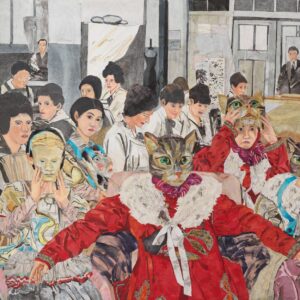Creating art is a powerful outlet for human thought and imagination. Likewise, creative art assignments in the classroom can provide opportunities unique to one-of-a-kind learning experiences, enhancing students’ creative thinking and ability to visualize ideas. In this post, the numerous benefits of art assignments in the classroom will be discussed, including the development of creative thinking skills and the ability to effectively communicate ideas visually.
From elementary school to college, art assignments give students an outlet for working through their imagination and troubleshooting problems through visual communication. The yearly art project contests and competitions in school grades provide incredible opportunities for students to hone their creative thinking skills.
The benefits of art assignments in enhancing student creativity and expression are substantial, and using a UK assignment service can provide additional support to help students fully explore their artistic potential. UKWritings.com offers tailored writing assistance to help students succeed in their creative projects. One major benefit of creative art projects for students is the creation of visually oriented mental images. Creating these images takes skills that can be learned and honed. Moreover, students also gain an understanding of how to express their thoughts and ideas visually. As an example, a student may draw himself sitting alone in a house with sadness sitting beside him next to a pile of empty plates.
The Power of Visual Communication
This applied skill is becoming more important with each passing generation, as we increasingly rely upon the art of visual communication to convey information, feelings and ideas assignments are still critical as they extend and develop to visually describe images through colours and shapes. student to find new ways allowing words to step aside and make room for a more universal language.
Art assignments compel students to think concretely about how to depict abstract constructs and concepts, such as an emotion, on a two-dimensional canvas or on a three-dimensional clay model. Accordingly, as Todorov puts it, ‘to make things with and using one’s own hands is a manifestation of how one thinks’. Thinking through making not only trains students to become more sophisticated thinkers through the formulation of ideas into concrete images, but it also builds symbolic and metaphorical capacities, which are invaluable assets to many scholarly and professional fields.
Fostering Creativity and Imagination
The most important benefit of art assignment is that it can help to improve their creativity and imagination.
Art assignments greatly enhance student creativity and expression, and using assignment services available online can offer additional support and resources to help them cultivate their skills further. Art is different from many other school subjects. For example, while science and math may involve learning formulas and recalling them for tests, art focuses on letting students come up with new things. When students get an art assignment, they have to use their creativity to make a new and original piece of artwork.
And because open-ended prompts can have a variety of interpretations and solutions, they encourage students to try out different perspectives while staying open to the possibilities. As they experiment with potential courses of action, they discover that there’s more than one way to accomplish a goal or express something, expanding their creative habit of mind from a hobby to a core skill.
Developing Critical Thinking Skills
And while art is frequently characterised by feelings and the creative process, it is also laden with critical thinking. Art projects require young people to make decisions every step of the way during the creative process. They must select a medium or multiple materials, compose a finished product, choose colour combinations, and determine how to represent an idea in a visual form. These choices incorporate analysis, evaluation and problem-solving.
Furthermore, much of the artwork itself is accompanied by a reflection portion requiring students to describe their artistic decisions or process. Such reflection promotes metacognition – thinking about one’s thinking – which is also an integral part of critical thinking. By articulating their thought process for themselves and others, students become more cognisant of their thinking patterns and accordingly approach problems in a more deliberate manner.
Enhancing Self-Expression and Emotional Intelligence
Art can create a safe platform for the expression of thoughts and feelings, and provide an expression outlet for those who find it difficult to express themselves verbally. Art can allow a student to work through difficult feelings and experiences, or it can act as a vehicle of communication for those students with challenging emotions or experiences.
The art assignment serves to help students gain awareness of their own emotions and learn to express them in healthy ways, which is part of the development of emotional intelligence that will support them in growth and social interactions throughout their lives. In the process of creating art reflective of their inner world, students often learn more about their own thoughts and feelings, which can lead to greater self-awareness and self-understanding.
Building Confidence and Self-Esteem
Finishing an art assignment can also give students a sense of accomplishment, which can build self-esteem. In academic classes and lessons, there are often correct and incorrect answers. In art, there isn’t a single correct way to complete an assignment, which means that students can feel successful completing the project in a way that is unique to their style, even if it doesn’t look like anyone else’s projects.
Most importantly, students are able to see, in visual terms, the success of their own ideas. This is a powerful incentive to take more risks next time, to keep on expressing themselves freely. Kids who are able to ‘get it out’ through their art at school become more confident speakers and thinkers, and they become more willing to share their ideas in other areas of their lives.
Improving Fine Motor Skills and Hand-Eye Coordination
The mental and emotional advantages of art projects is a big factor, but there are also physical advantages that often go unappreciated. Some of this is tied to the fine motor skills that are involved in many art projects, such as drawing fine lines, cutting precise shapes or manipulating tiny objects.
And these kinds of physical skills are important for many everyday tasks and potential future jobs. From writing neatly and using a computer to performing delicate surgical procedures or circuit-board repairs, the movement skills taught in art classes can be easily generalised.
Fostering Cultural Awareness and Appreciation
Many art assignments introduce students to diverse art styles, techniques and traditions from different societies and eras. This diversity can serve to broaden students’ horizons and exoticise the human past; it can also encourage students to celebrate and value other ways of being and seeing that differ from their own. When students are tasked with studying and making art based on these styles and traditions, they gain a deeper understanding of other cultures and peoples.
What’s more, it can help students step outside their cultural frame of reference and into another one: they can engage with art as a tool for truly knowing the feelings of another person. This is a perfect example of how we can use art to make our students more culturally sensitive, more empathetic – more culturally aware and prepared for citizenship in our globally connected world.
Encouraging Collaborative Learning
Although students often work individually on art assignments, group art projects are also common in art education. By working together on group projects, students learn how to work with others, share ideas, compromise, and integrate their creative visions towards a common goal. Such collaboration enables students to cultivate valuable social skills they will use throughout their schooling and working lives.
Students can also learn from each other through collaborative assignments, be it in art production or viewing. Collaborative art assignments give students an opportunity to learn multiple processes and techniques, and to conceptualise multiple ways of presenting their subject matter. In such a collaborative environment, feedback on artwork, together with students’ ability to articulate their thoughts and opinions about a piece of art, supports learning to communicate and appreciate other points of view.
Integrating Cross-Curricular Learning
An art assignment also has a cross-curricular quality – because a nationally mandated art project on historical costumes would involve researching history; understanding textile science; and math skills, for example, to learn to draft a pattern. This can help young people see the connections between subjects by understanding how knowledge can be applied in the pursuit of creative, practical outcomes.
By embedding learning from other subjects in an artistic project, teachers can reinforce learning across the curriculum, subjects more authentic. It is likely to lead to more pleasure in learning; and a deeper understanding of the world.
Preparing for Future Careers
Increasingly, creativity, innovation and adaptability are highly regarded skills that are necessary for the highly volatile jobs marketplace. Assignments that incorporate art encourage those abilities, helping students prepare for a diverse range of future careers; in fact, even in jobs that are distinctly non-artistic, the ability to think and communicate visually, and to approach problems from different directions, can be a great advantage.
Additionally, the digital age has spawned many more careers in technology-infused areas that still require artful skills and sensibilities. For example, much of the field of graphic design relies on technology, but involves the same kind of creative thinking and visual communication skills art assignments encourage. The same is true of user experience design, digital animation, and game development.
Conclusion
When engaging students in art assignments, countless benefits are at play. Creativity and self-expression are immensely developed, and student skill and cognitive development is enhanced through the cross-curricular linkages that art education fosters. In short, art assignments build a wide variety of skills beyond those attached to the discipline itself. They enable children to develop imagination, train their critical and reasoning skills, boost their emotional intelligence and self-confidence, expose them to the arts and cultures of the past and present, and much more. Given the society trends toward celebrating innovation and creativity, the importance of art education can not be overstated. For the future success of our children in their personal lives, academic endeavours and future careers, it is important to ensure that art remains a fundamental part of the curriculum in schools.
And by giving students opportunities to see, make and show, we help them become more complete, confident, creative human beings. The habits of mind developed during the course of art assignments help those who will be artists as well as all students as they confront an ever more complicated, imagistic world.
FAQ
Q: Are art assignments only beneficial for students who are naturally artistic?
A: No, every student learns something useful from an art assignment, no matter how naturally gifted they are as artists. Art projects help develop useful abilities such as creativity, problem-solving, and self-expression.
Q: How can parents support their children’s artistic development at home?
A: Parents can raise artistic children by giving them materials to create art, posting their children’s artwork in the house, taking their children to museums, and creating art as a family.
Q: Can art assignments help students who struggle in other academic areas?
A: Yes, I think it can help boost self-esteem, and give kids other ways to show what they know, which sometimes they’re not good at via academic measures.
Q: How do digital art assignments compare to traditional art projects?
A: Both digital art and traditional art projects help students in their study. I believe that technology skills can be learned in the digital art assignments while the traditional art projects provide more tactile activities. If possible students should be exposed to both.
Q: How can teachers incorporate art into non-art subjects?
A: Visual aids and lessons, stimulating creative projects, and using arts-based activities in assignments across the curriculum can help teachers turn on the learning light.



